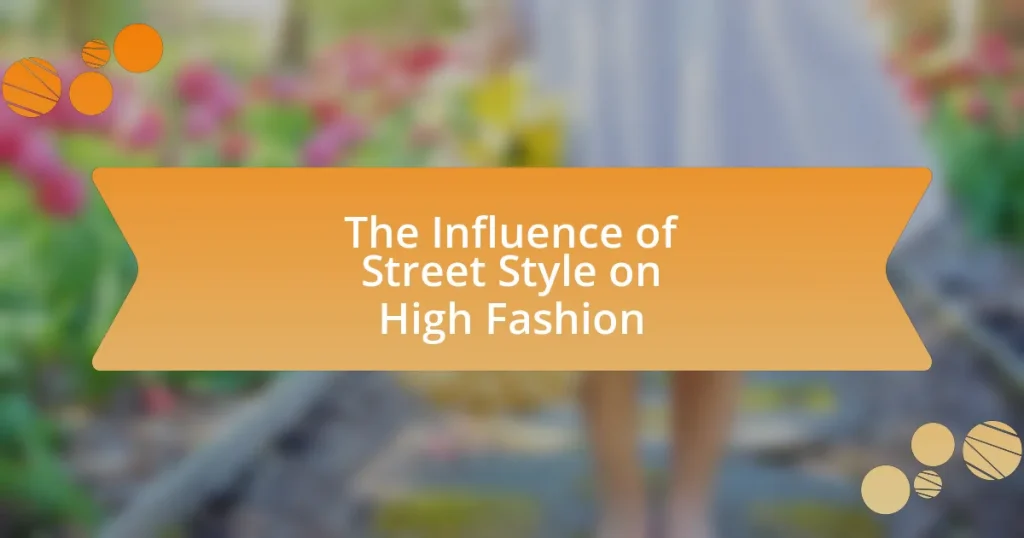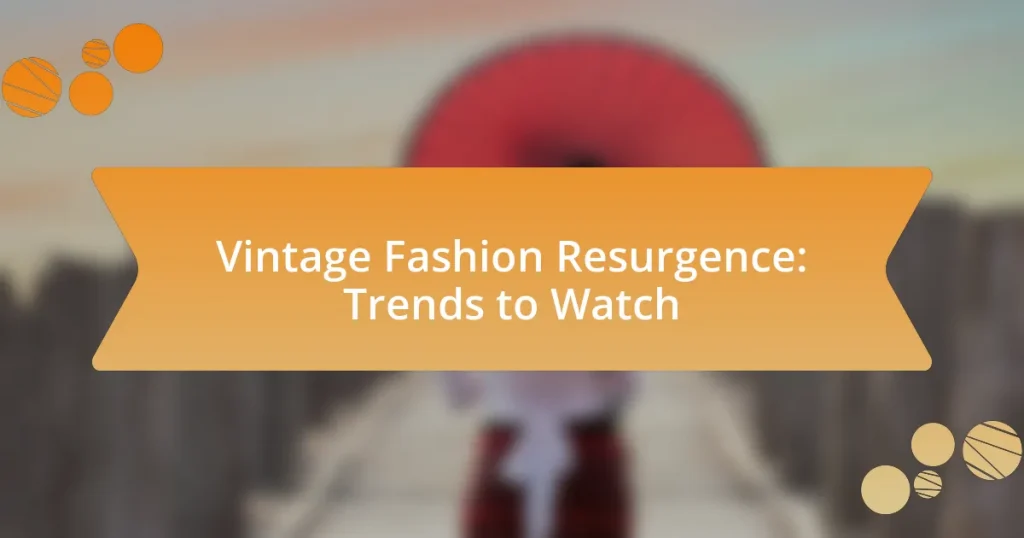The article examines the significant influence of street style on high fashion, highlighting how designers incorporate elements from streetwear into their collections, such as casual silhouettes and bold graphics. It traces the evolution of street style from niche subcultures to mainstream fashion, emphasizing its role in promoting inclusivity and individual expression. The article also discusses the impact of cultural movements, social media, and current trends on the fashion industry, as well as the challenges and rewards high fashion brands face when integrating street style elements. Additionally, it provides practical tips for individuals looking to blend street style with high fashion aesthetics.
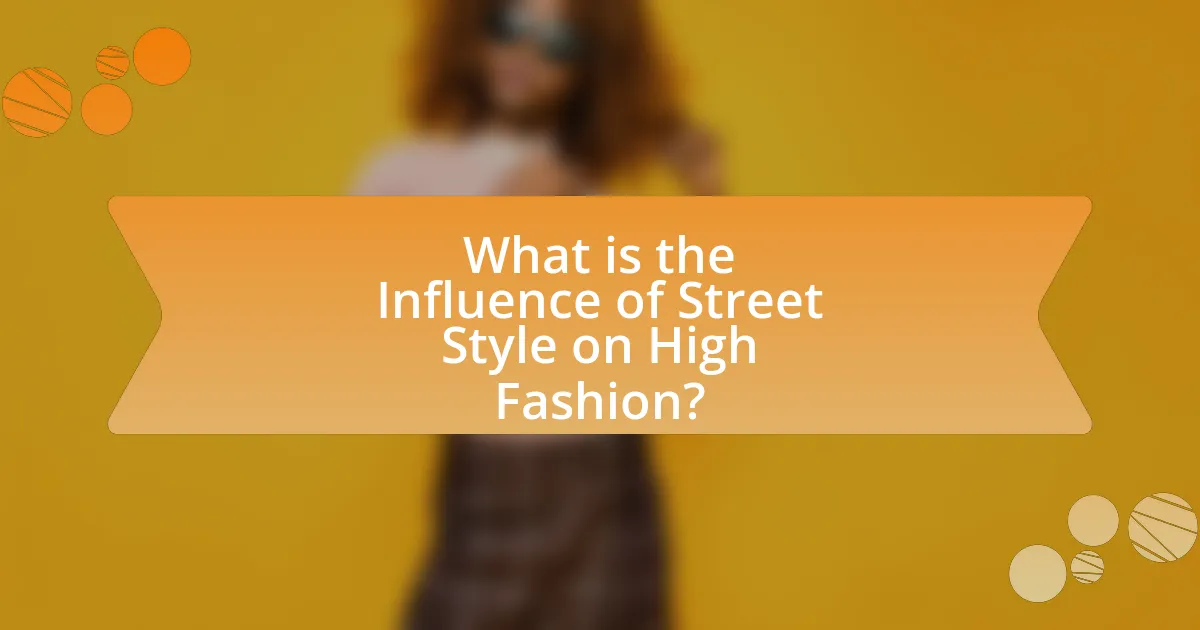
What is the Influence of Street Style on High Fashion?
Street style significantly influences high fashion by introducing fresh trends and democratizing fashion aesthetics. Designers often draw inspiration from streetwear, incorporating elements like casual silhouettes, bold graphics, and diverse cultural references into their collections. For instance, the rise of athleisure, characterized by comfortable yet stylish clothing, emerged from street style and has been embraced by luxury brands such as Gucci and Balenciaga. This blending of high fashion with street style reflects a shift towards inclusivity and accessibility in the fashion industry, as seen in the increasing collaborations between high-end designers and streetwear labels.
How has street style evolved over the years?
Street style has evolved significantly over the years, transitioning from a niche subculture to a dominant influence in mainstream fashion. Initially, in the 1950s and 1960s, street style was characterized by youth-driven movements, such as the Beatniks and Mods, who expressed their identities through distinctive clothing choices. By the 1980s and 1990s, street style began to incorporate elements from hip-hop culture, punk, and skateboarding, leading to a more diverse and eclectic aesthetic.
In the 2000s, the rise of social media platforms allowed street style to gain visibility, with fashion bloggers and influencers showcasing their outfits online, further blurring the lines between high fashion and everyday wear. This democratization of fashion has led to high-end designers increasingly drawing inspiration from street style, as seen in collections by brands like Off-White and Balenciaga, which incorporate urban aesthetics and casual silhouettes.
The evolution of street style reflects broader societal changes, including shifts in cultural norms and the increasing acceptance of individual expression in fashion. This ongoing transformation highlights street style’s role as a catalyst for innovation within the fashion industry, influencing trends and challenging traditional notions of luxury and style.
What cultural movements have shaped street style?
Cultural movements that have shaped street style include punk, hip-hop, and skate culture. The punk movement of the 1970s introduced a rebellious aesthetic characterized by DIY fashion, leather jackets, and bold hairstyles, influencing street style significantly. Hip-hop culture emerged in the 1980s, bringing oversized clothing, athletic wear, and sneakers into mainstream fashion, which became staples of urban street style. Skate culture, also from the 1980s, contributed graphic tees, baggy pants, and skate shoes, further diversifying street style. Each of these movements has left a lasting impact on how street style is perceived and adopted in high fashion, demonstrating the interplay between cultural expression and fashion trends.
How do social media platforms impact street style trends?
Social media platforms significantly influence street style trends by providing a space for rapid dissemination and democratization of fashion ideas. These platforms enable users to share their personal styles, which can quickly gain traction and inspire others globally. For instance, Instagram’s visual nature allows influencers and everyday users alike to showcase unique outfits, leading to viral trends that can shift consumer preferences almost overnight. According to a study by the Fashion Institute of Technology, 70% of consumers reported that social media influences their fashion choices, highlighting the platforms’ role in shaping street style.
Why is street style significant in the fashion industry?
Street style is significant in the fashion industry because it serves as a direct reflection of cultural trends and individual expression, influencing high fashion designers and brands. This grassroots movement democratizes fashion, allowing diverse voices and styles to emerge, which has been evidenced by major fashion houses incorporating streetwear elements into their collections, such as Gucci and Off-White. The rise of social media platforms has further amplified street style’s impact, enabling real-time sharing and inspiration, which has reshaped how trends are created and disseminated within the industry.
What role does street style play in fashion innovation?
Street style serves as a catalyst for fashion innovation by reflecting real-world trends and individual expression, which often influences high fashion designers. This grassroots approach to fashion allows for the emergence of new styles and ideas that challenge traditional norms, as seen in the rise of athleisure and oversized silhouettes, which originated from streetwear. The impact of street style is evidenced by major fashion houses incorporating elements from urban culture into their collections, such as Gucci’s collaboration with streetwear brands and Balenciaga’s use of everyday clothing aesthetics. This integration demonstrates how street style not only inspires but also reshapes the fashion landscape, making it more inclusive and diverse.
How does street style reflect societal changes?
Street style reflects societal changes by serving as a visual representation of cultural shifts, social movements, and individual identities. For instance, the rise of streetwear in the 1990s coincided with the emergence of youth subcultures and a growing emphasis on casual, expressive fashion, which challenged traditional fashion norms. This evolution is evidenced by the incorporation of elements from hip-hop, skate culture, and punk into mainstream fashion, illustrating how societal attitudes towards race, class, and gender influence style choices. Additionally, the increasing visibility of marginalized communities in fashion highlights broader societal conversations about inclusivity and representation, further demonstrating the connection between street style and societal dynamics.
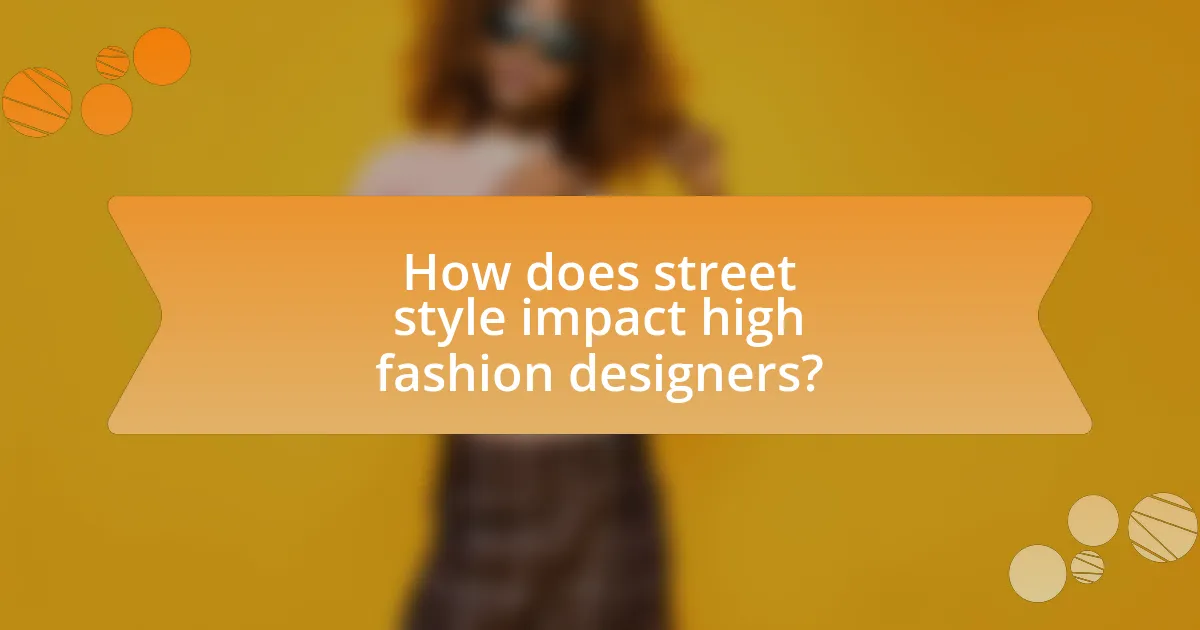
How does street style impact high fashion designers?
Street style significantly influences high fashion designers by shaping trends and consumer preferences. Designers often draw inspiration from the authentic, diverse aesthetics found in street fashion, which reflects real-world wearability and cultural movements. For instance, the rise of athleisure, popularized by street style, has led luxury brands like Balenciaga and Gucci to incorporate sporty elements into their collections, demonstrating a direct correlation between street fashion and high-end design. This impact is further evidenced by the increasing presence of streetwear brands in high fashion runways, such as Off-White and Supreme, which have blurred the lines between luxury and casual wear, ultimately redefining the fashion landscape.
What are the key ways street style influences high fashion collections?
Street style influences high fashion collections primarily through the incorporation of casual aesthetics, real-world wearability, and cultural diversity. High fashion designers often draw inspiration from the authentic, everyday outfits seen on the streets, which reflect current societal trends and attitudes. For instance, the rise of athleisure in high fashion can be traced back to street style, where comfort and functionality became paramount, leading brands like Balenciaga and Gucci to integrate sporty elements into their collections. Additionally, street style showcases a variety of cultural influences, allowing high fashion to embrace and celebrate diversity, as seen in collections that feature bold prints and styles inspired by urban environments. This dynamic exchange between street style and high fashion not only keeps the latter relevant but also fosters innovation and creativity within the industry.
How do designers incorporate street style into their runway shows?
Designers incorporate street style into their runway shows by blending urban fashion elements with high-fashion aesthetics. This integration often includes the use of casual silhouettes, bold graphics, and eclectic accessories that reflect contemporary streetwear trends. For instance, designers like Off-White and Balenciaga have successfully merged street style by showcasing oversized silhouettes and graphic tees, which resonate with youth culture. Additionally, runway presentations frequently feature models styled in a way that mirrors everyday street fashion, emphasizing comfort and individuality. This approach not only appeals to a broader audience but also reflects the evolving nature of fashion, where street style increasingly influences luxury brands.
What are some examples of successful collaborations between street style and high fashion?
Successful collaborations between street style and high fashion include the partnership between Off-White and Nike, which resulted in the “The Ten” collection, blending streetwear aesthetics with high-end design. Another notable example is the collaboration between Supreme and Louis Vuitton, which merged the streetwear brand’s iconic logo with luxury fashion, leading to a highly sought-after collection that sold out rapidly. Additionally, the collaboration between Adidas and designer Yohji Yamamoto for Y-3 exemplifies the fusion of athletic street style with avant-garde fashion, showcasing innovative designs that appeal to both streetwear enthusiasts and high fashion consumers. These collaborations demonstrate how street style influences high fashion, creating unique products that resonate with diverse audiences.
Why do high fashion brands look to street style for inspiration?
High fashion brands look to street style for inspiration because it reflects authentic, real-world fashion trends that resonate with consumers. Street style captures the creativity and individuality of everyday people, providing designers with fresh ideas that can be adapted for high fashion collections. This connection to grassroots fashion allows brands to stay relevant and appeal to a broader audience, as evidenced by the increasing incorporation of casual and diverse styles in runway shows and collections. For instance, the rise of athleisure and oversized silhouettes in luxury fashion can be traced back to streetwear trends, demonstrating how high fashion adapts and evolves based on street style influences.
How does street style help brands connect with younger audiences?
Street style helps brands connect with younger audiences by reflecting their values and lifestyle preferences, making the brands more relatable and authentic. This connection is evident as younger consumers increasingly seek individuality and self-expression in their fashion choices, which street style embodies. According to a 2021 study by McKinsey & Company, 67% of Gen Z consumers prefer brands that align with their personal values, and street style often showcases diversity and inclusivity, resonating with this demographic. Additionally, social media platforms amplify street style trends, allowing brands to engage directly with younger audiences through user-generated content and influencer partnerships, further solidifying this connection.
What are the risks and rewards of adopting street style elements?
Adopting street style elements presents both risks and rewards. The primary reward is the potential for increased creativity and individuality in fashion, as street style often emphasizes personal expression and innovation. This can lead to unique fashion statements that resonate with diverse audiences, enhancing brand identity and appeal. For instance, high fashion brands like Balenciaga and Off-White have successfully integrated street style, resulting in significant sales growth and cultural relevance.
Conversely, the risks include the possibility of alienating traditional customers who may not resonate with the more casual or edgy aesthetics of street style. Additionally, there is a risk of brand dilution if a luxury brand overly adopts street style elements, potentially undermining its exclusivity and perceived value. For example, when luxury brands incorporate too many casual elements, they may lose their high-end appeal, as seen in the backlash against certain collaborations that blurred the lines between luxury and mass-market fashion.
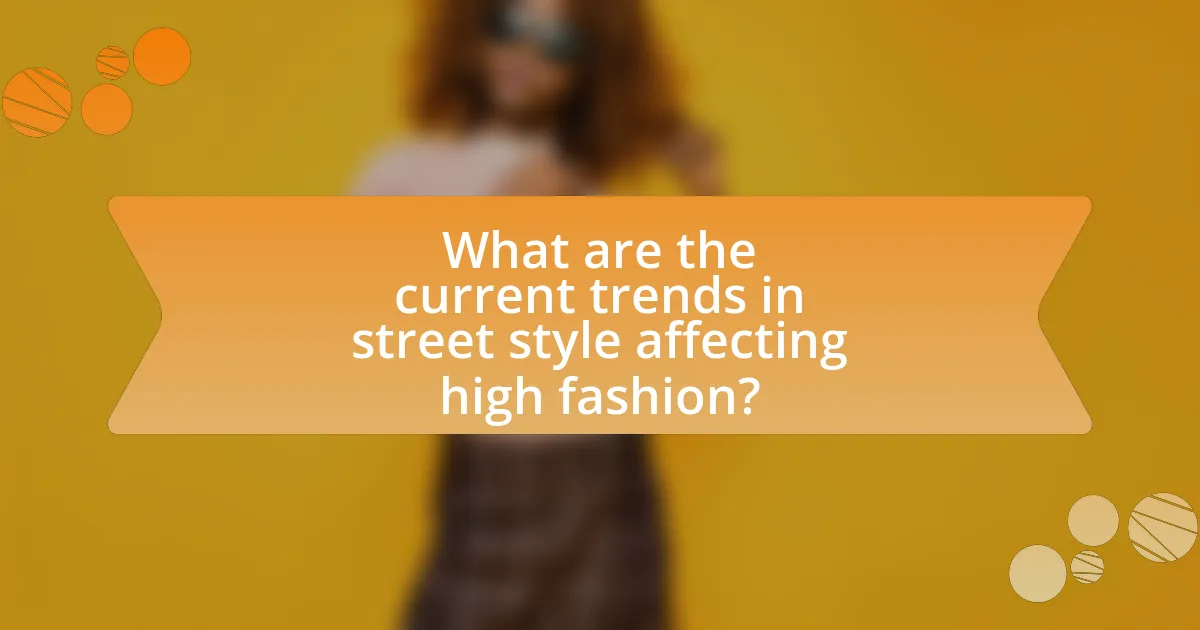
What are the current trends in street style affecting high fashion?
Current trends in street style significantly influence high fashion by promoting casual, oversized silhouettes, vibrant colors, and a mix of high and low fashion elements. Designers are increasingly incorporating streetwear aesthetics, such as graphic tees, sneakers, and utilitarian pieces, into their collections, reflecting a shift towards comfort and individuality. For instance, brands like Balenciaga and Off-White have successfully merged street style with luxury, showcasing how urban influences can redefine high fashion. This trend is validated by the rise of social media platforms, where influencers and everyday fashion enthusiasts showcase their styles, further blurring the lines between streetwear and high fashion.
How do specific street style trends manifest in high fashion collections?
Specific street style trends manifest in high fashion collections through the incorporation of casual aesthetics, bold graphics, and diverse cultural influences. High fashion designers often draw inspiration from urban environments, reflecting the styles seen on the streets, such as oversized silhouettes, athleisure elements, and eclectic layering. For instance, brands like Balenciaga and Off-White have successfully integrated streetwear elements, showcasing items like hoodies and sneakers in their runway shows, which were previously considered casual wear. This shift is supported by the rise of social media platforms, where street style is widely shared and celebrated, influencing designers to adopt these trends to appeal to a broader audience.
What are the most popular street style trends today?
The most popular street style trends today include oversized silhouettes, vibrant colors, and a mix of vintage and contemporary pieces. Oversized clothing, such as baggy jeans and large jackets, has gained traction due to its comfort and relaxed aesthetic, often seen in urban environments. Vibrant colors, particularly neon and bold patterns, are frequently incorporated into outfits, reflecting a playful approach to fashion. Additionally, the blending of vintage items with modern apparel showcases a sustainable mindset, as consumers increasingly seek unique, second-hand finds. This trend is supported by the rise of thrift shopping and platforms that promote circular fashion, indicating a shift in consumer behavior towards more environmentally conscious choices.
How do these trends differ across various global fashion capitals?
Trends in street style differ significantly across global fashion capitals such as New York, Paris, Milan, and Tokyo. In New York, street style emphasizes practicality and individualism, often showcasing a mix of high-end and casual wear, reflecting the city’s diverse culture and fast-paced lifestyle. Paris, on the other hand, leans towards a more polished and sophisticated aesthetic, where effortless chic is paramount, often incorporating vintage elements and designer pieces. Milan is characterized by bold colors and luxurious fabrics, with a focus on craftsmanship and tailoring, aligning with its reputation for high fashion. Tokyo presents a unique blend of avant-garde and traditional influences, where street style often features experimental silhouettes and vibrant patterns, showcasing the city’s innovative approach to fashion. These differences highlight how local culture, lifestyle, and historical context shape the interpretation of street style in each city.
What challenges do high fashion brands face when integrating street style?
High fashion brands face significant challenges when integrating street style, primarily due to the clash of brand identity and consumer expectations. High fashion is often associated with exclusivity and luxury, while street style embodies accessibility and individuality. This dichotomy can lead to a dilution of brand prestige if not managed carefully.
Moreover, high fashion brands must navigate the rapid pace of street style trends, which can change quickly and unpredictably, making it difficult to align their seasonal collections with current streetwear aesthetics. Additionally, there is a risk of cultural appropriation, where high fashion brands may be criticized for borrowing elements from street style without proper acknowledgment or respect for the cultural origins, leading to backlash from consumers and communities.
These challenges are compounded by the need for high fashion brands to maintain their traditional craftsmanship and quality standards while adapting to the more casual and often less structured nature of street style. Balancing these elements requires strategic planning and a deep understanding of both markets.
How can brands maintain their identity while embracing street style?
Brands can maintain their identity while embracing street style by integrating core brand elements into street-inspired designs. This approach allows brands to stay true to their heritage while appealing to contemporary fashion trends. For instance, luxury brands like Gucci and Balenciaga have successfully incorporated street style by using bold graphics and casual silhouettes, yet they retain their signature logos and craftsmanship, which reinforces their brand identity. This strategy not only attracts a younger audience but also preserves the brand’s essence, as evidenced by the increased sales and brand loyalty observed in these companies after adopting street style elements.
What are common misconceptions about street style in high fashion?
Common misconceptions about street style in high fashion include the belief that it lacks sophistication and is purely casual. In reality, street style often incorporates high-quality materials and innovative designs, reflecting the creativity and craftsmanship found in traditional high fashion. Additionally, many assume that street style is only for the young and trendy; however, it has been embraced by diverse age groups and cultures, influencing major fashion houses and runway collections. This influence is evident in the way designers like Balenciaga and Off-White have integrated streetwear elements into their collections, demonstrating that street style is a legitimate and respected facet of the fashion industry.
What practical tips can fashion enthusiasts apply from street style to high fashion?
Fashion enthusiasts can apply several practical tips from street style to high fashion, such as mixing high-end pieces with casual items, embracing bold colors and patterns, and prioritizing personal expression over trends. Mixing high-end pieces with casual items, like pairing designer shoes with denim, creates a balanced look that reflects both luxury and everyday wear. Embracing bold colors and patterns, often seen in street style, allows individuals to stand out and showcase their personality, which is increasingly valued in high fashion. Prioritizing personal expression encourages fashion enthusiasts to curate outfits that resonate with their identity rather than strictly adhering to seasonal trends, aligning with the growing movement towards individuality in the fashion industry.
How can individuals incorporate street style elements into their wardrobe?
Individuals can incorporate street style elements into their wardrobe by mixing casual and trendy pieces with classic items. This approach allows for a unique blend that reflects personal style while embracing current fashion trends. For example, pairing oversized graphic tees with tailored trousers or layering a denim jacket over a dress can create a balanced look that embodies street style. Additionally, incorporating accessories like chunky sneakers, beanies, or statement bags can enhance the overall aesthetic. Street style often emphasizes individuality, so experimenting with bold colors, patterns, and textures can further personalize the wardrobe.
What are the best practices for blending street style with high fashion aesthetics?
The best practices for blending street style with high fashion aesthetics include mixing casual and tailored pieces, incorporating bold accessories, and focusing on unique silhouettes. By combining relaxed streetwear items, such as oversized hoodies or sneakers, with structured high-fashion elements like tailored blazers or designer handbags, individuals can create a balanced look that showcases both styles. Additionally, using statement accessories, such as chunky jewelry or eye-catching bags, can elevate a casual outfit to a more sophisticated level. Emphasizing unique silhouettes, such as pairing wide-leg trousers with a fitted top, allows for a dynamic visual contrast that is often celebrated in both street style and high fashion. These practices are supported by the ongoing trend of designers like Balenciaga and Off-White, who have successfully integrated streetwear influences into their high-fashion collections, demonstrating the viability of this aesthetic blend.
